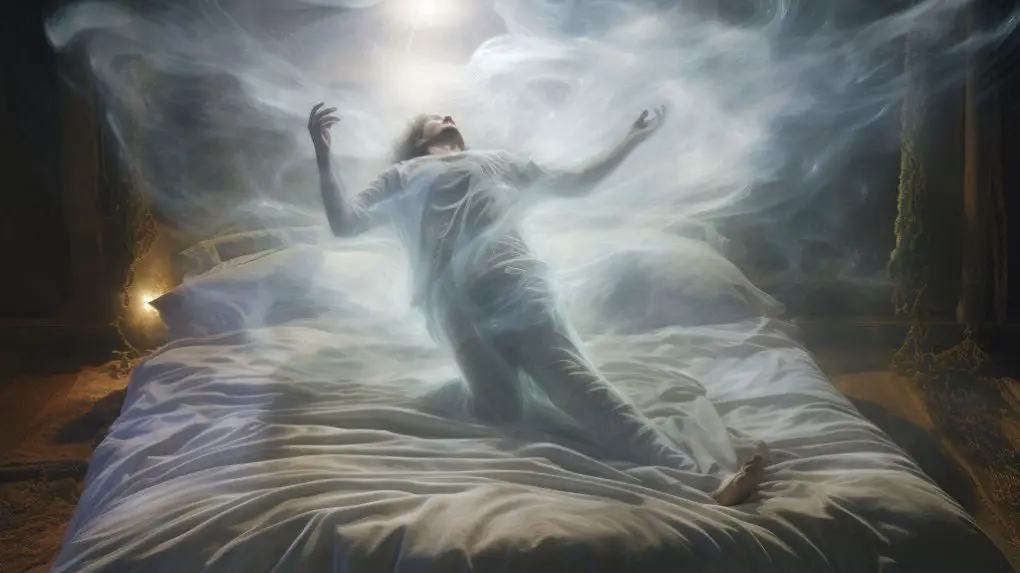Have you ever wondered what leaving your physical body and exploring the world from a completely different perspective would be like? This is possible through Out of Body Experiences (OBEs), also known as astral projection.
In this guide, we’ll explore what OBEs are and how you can achieve them as a beginner.
What are Out of Body Experiences?
An Out of Body Experience, often abbreviated as an OBE, is a fascinating, mysterious, and, for some, even transformative phenomenon that is often described as stepping outside of one’s physical body and observing oneself and the world from a unique and detached perspective. This sensation occurs when you perceive that you have seemingly left your own body and physical confines, venturing out and unconventionally experiencing the world.
During an OBE, the range of experiences can vary dramatically from person to person. Some individuals report unusual sensations and altered states of consciousness that radically diverge from their typical day-to-day awareness. How people interpret these experiences is often as diverse as the experiences themselves.
Certain people might recount a sensation of floating or flying, relishing in the feeling of weightlessness. Others may describe a more tangible experience, such as suddenly finding themselves in an entirely different location, wholly removed from their physical surroundings.
Also read A Journey to Afterlife: Examining Ancient Egyptians Beliefs about Death
Why Do People Want to Have an OBE?
The motivation for individuals to seek out an Out of Body Experience is diverse and multifaceted. At the heart of this desire is often a deep yearning for spiritual growth, an insatiable curiosity about the nature of consciousness, or a profound desire to explore the realm that lies beyond the physical boundaries of their bodies.
OBEs offer the potential for a unique and profound exploration of self and reality. For some, it represents a way to unlock new levels of understanding, facilitating a profoundly personal journey into their spiritual and metaphysical beliefs.
Additionally, some individuals have reported experiencing spontaneous OBEs during intense moments, such as near-death experiences, or even in more serene situations, such as meditation or sleeping. These unexpected occurrences can give individuals a fresh perspective on life and existence.
Brief History of OBEs
Out of Body Experiences have been recognized and discussed in human history for millennia, stretching across diverse cultures, periods, and religions. Many cultures have incorporated the concept of OBEs into their spiritual and philosophical practices, viewing them as a means of spiritual enlightenment, a form of astral projection, or even a soul journey.
The concept of OBEs has also sparked considerable interest in psychical research. Both anecdotal reports and some scientific studies over the years have extensively explored this topic, seeking to understand the nature and mechanisms of this intriguing phenomenon. Despite some skepticism, the accumulation of numerous accounts worldwide suggests that OBEs may indeed be a genuine, albeit not fully understood, phenomenon.
It is essential to highlight that the interpretation of OBEs is highly individual and often dependent on personal beliefs, cultural background, and the context in which the experience occurs. While to some, it might be a profoundly spiritual event, to others, it may be explained through neuroscience, psychological factors, or regarded as an unusual yet natural occurrence.
Understanding Your Physical Body
Before venturing into Out of Body Experiences, a fundamental understanding of your physical body is essential. A clear grasp of your physical body and its workings can aid in comprehending the complexities of the OBE phenomenon and the intricate interplay between your physical and supposed astral bodies. Recognizing the distinctions between these two entities is a crucial step in preparing for and navigating an OBE.
Anatomy of the Physical Body
The human body is a marvel of natural engineering. It is an intricately woven tapestry of bones, muscles, organs, and other tissues that work in a beautifully choreographed harmony to support life. Our bodies function through an intricate dance of biological processes, and every element plays a crucial role.
Understanding the fundamental anatomy of the human body and the underlying physiological mechanisms not only fosters a greater appreciation for our physical selves but also offers intriguing insights into how OBEs might occur and what potential changes may transpire during such an experience.
You may also like Astral Projection
Differences Between the Physical and Astral Bodies
In discussions around OBEs, a recurring concept is the existence of a celestial body, purported to be a distinct entity from the physical body. The astral body is commonly described in esoteric literature as a more subtle, spiritual counterpart of the physical body, which can separate from it during an OBE.
While the physical body is restricted by the laws of physics and the material limitations of the world we live in, the astral body, on the other hand, is often described as being unhindered by these constraints. It is suggested that the celestial body can traverse time and space in manners not conceivable within the confines of our physical existence. This concept, although fascinating, is an area of ongoing debate and is not widely accepted within mainstream science.
Preparation of the Physical Body for OBEs
Embarking on an attempt to experience an OBE requires careful preparation of your physical body. Achieving a state of profound relaxation and comfort is essential. This state can be reached through various techniques, each of which aids in grounding and calming the body, setting the stage for a potential OBE.
Meditation practices can play a significant role here, fostering a sense of deep inner calm and heightened self-awareness. Breathing exercises also contribute to this preparation by reducing anxiety, slowing heart rate, and enhancing overall relaxation. Progressive muscle relaxation, a method where you tense and then release different muscle groups, is another helpful technique to release bodily tension and prepare the brain for an OBE.
As you prepare for such a profound and potentially transformative experience, it is crucial to approach it with an open mind, patience, and a sense of exploration. Your mental state, along with your physical preparation, will greatly influence your experience.
Techniques for Achieving Out-of-Body Experiences
Achieving an Out of Body Experience (OBE) often requires a blend of focus, relaxation, and the right techniques. There is no one-size-fits-all approach, as what works best can vary from individual to individual. However, several methods have been widely utilized and reported to be effective. Here are some of the most commonly employed techniques:
Relaxation Techniques
One of the initial steps towards achieving an OBE involves reaching a profound state of relaxation. This deep relaxation state serves as a foundation from which the exploratory journey of an OBE can commence. To attain this, you can employ a range of activities such as meditation, deep breathing, progressive muscle relaxation, or yoga. The fundamental idea is to calm your physical body to such an extent that your consciousness can more readily transcend the physical plane, making it potentially easier to initiate an OBE.
Visualization Techniques
A further technique involves the use of visualization. This method encompasses the active use of your imagination to form a vivid mental image of your astral self disassociating from your physical body. For instance, a common visualization practice entails imagining a cord or a rope connecting your physical body to your astral body. In your mind’s eye, you might then envisage this cord breaking or your astral self gently floating away, thereby allowing the astral body to move freely and begin its exploratory journey.
Meditation Techniques
Meditation is a potent tool often associated with achieving OBEs. Specific meditation techniques can help create a unique state of consciousness where your physical body appears to fall asleep, while the rest of your mind remains alert and awake. This altered state of consciousness, sometimes referred to as the hypnagogic state, is often reported as a stage from which OBEs can be initiated. By centering your mind on a single point or focusing on your breath, you can cultivate this particular state of consciousness conducive to OBEs.
Breathing Techniques
In addition to standard relaxation techniques, specialized breathing techniques can be utilized to induce an OBE. Deep, rhythmic, and controlled breathing can help calm the mind, reduce heart rate, and induce a meditative state. Some individuals also incorporate auditory stimulation tools like binaural beats or other specific sound frequencies.
These soundscapes are designed to stimulate certain brainwave frequencies, thus inducing a state of vibration in the awake body. Many people who have experienced OBEs describe a unique vibrational state preceding the experience, suggesting that these techniques can potentially facilitate the onset of an OBE.
Remember, these techniques require practice and patience. Not everyone will experience an OBE, and for those who do, the experience may not be the same each time. It’s essential to approach these practices with an open mind, curiosity, and respect for the complexity of our consciousness.
Don't miss Astral Bodies – Discover What They Are and Their Purpose
Astral Projection
Astral projection represents a specialized form of Out of Body Experience. In this scenario, it is purported that the astral body, often considered a spiritual counterpart or energy body, separates from the physical body.
This astral body is then believed to be capable of traveling to visit distant locations and locales, interacting with different forms of consciousness, and exploring the non-physical, metaphysical realms of existence. Astral projection has been described in various cultures and philosophies, each with unique interpretations and nuances. Here are some strategies that may facilitate the experience of astral projection:
Tips for Achieving Astral Projection
- Relax Your Physical Body: Begin by easing your physical body into a deeply relaxed state. This can be achieved through practices such as meditation, deep breathing, progressive muscle relaxation, or yoga. A relaxed physical body can form the foundation from which your consciousness or astral body attempts to separate.
- Focus Your Mind: With your physical body at ease, the next step involves honing your mind’s focus onto a single point. This might be a specific visualization, a mantra, or even the rhythm of your own breath. By concentrating on a single point, you can help guide your mind away from the usual stream of thoughts and towards the state of consciousness necessary for astral projection.
- Visualization: Visualization plays a crucial role in astral projection. Imagine a scenario where you are gently separating from your physical body and embarking on a journey to another location. The more vivid and immersive this mental image, the more likely it is to guide your consciousness toward an astral projection experience.
- Stay Calm: If you begin to feel unusual sensations or encounter unexpected experiences, it is essential to remain calm and relaxed. Fear or agitation can interrupt the process and snap you back into full physical awareness. Approach the experience with curiosity and an open mind.
The Benefits of Astral Projection
Astral projection, the process of consciously separating the ‘astral body’ from the physical body, offers a multitude of potential benefits. These benefits can touch upon life’s personal, spiritual, and even philosophical aspects. The following sections delve into these areas of potential growth and understanding that may be fostered through astral projection.
Spiritual Growth and Enlightenment
From a spiritual standpoint, astral projection could offer an enriched understanding of one’s position within the cosmos. It may facilitate personal encounters with various realms or entities, leading to potentially profound and transformative experiences. These experiences can pave the way for accelerated spiritual growth and enlightenment, fostering a more profound sense of interconnectedness and unity with the universe. Through these astral travels, individuals might glean insights that shift their perception of existence and inspire a deeper sense of purpose or existential understanding.
Personal Development and Self-Awareness
Astral projection may also significantly contribute to personal development. Experiences of this nature can lead to heightened self-awareness and introspection. Encounters and experiences in the astral plane might challenge pre-existing beliefs or perceptions, catalyzing self-reflection and transformation. They can offer valuable insights into the nature of self, consciousness, and reality, thus promoting psychological and emotional growth. Moreover, the discipline, patience, and focus required to achieve astral projection can foster personal resilience and grit.
Exploring Beyond Physical Limitations
A unique advantage of astral projection lies in its potential to transcend the bounds of physical reality. It offers an opportunity to consciously explore different dimensions, realities, and, potentially, entities. This capability to navigate beyond physical limitations can foster a broader perspective on life and existence, extending one’s understanding of reality beyond everyday experiences. These explorations might evoke a sense of wonder, curiosity, and humility in the face of the vast unknown.
Navigating Astral Projection Safely
As intriguing and beneficial as astral projection might be, it’s crucial to approach it with an open mind, patience, and due respect for the intensity of the experiences. As each individual’s encounters with astral projection can vary greatly, it’s essential to be prepared for a spectrum of possibilities. Despite its intriguing potential, astral projection remains a subject of ongoing research, exploration, and debate within various fields, from metaphysics to psychology and neuroscience. Therefore, maintaining a balanced and cautious approach can ensure a safe and enriching journey into astral projection.
Related Article Mind Reading Prevention Strategies – Stopping Intrusive Thoughts
Common Out-of-Body Experiences
Body Experiences (OBEs) are diverse and personal. They can take many forms and come with varying intensity and duration, reflecting the individual’s mental and emotional state and familiarity with the phenomenon. Below are some common types of OBEs that individuals may encounter:
Types of Out of Body Experiences
- Spontaneous OBEs: These typically occur without prior intention or preparation, often in the context of near-death experiences or other unusual or traumatic circumstances. These experiences can be jolting due to their unexpected nature and can offer unique insights into the heart of consciousness and our perception of reality.
- Induced OBEs: These experiences are deliberately sought out and induced through specific techniques or practices such as meditation, visualization, or the use of specific sound frequencies. These deliberate efforts can lead to exploratory journeys beyond the physical body.
- Lucid Dreaming: In lucid dreaming, the dreamer gains awareness of their dream state and can consciously manipulate the dream environment. Many consider this a type of OBE as the dreamer often feels as if they are navigating an alternate reality.
- Sleep Paralysis: In this state, the mind is alert, but the body is unable to move, usually during the transitional phase between sleep and wakefulness. Some individuals report OBE-like sensations during sleep paralysis, such as feeling detached from their bodies or observing the environment from an external perspective.
- Near-Death Experiences (NDEs): NDEs often include reports of OBEs where individuals perceive themselves as leaving their bodies during a life-threatening event, followed by experiences of moving through tunnels, encountering spiritual beings, or having life reviews.
Symptoms of Out of Body Experiences
During an OBE, individuals may encounter a broad spectrum of sensations and symptoms. These can include:
- Feeling as though you are floating, flying, or moving without physical constraints.
- Observe yourself or your surroundings differently, as if you’re an external observer.
- Sensing a clear separation or disconnection between your physical body and what feels like your conscious self or “astral body.”
- Experiencing a sense of detachment or disconnection from your physical body.
How to Deal with Negative or Scary OBEs
Although OBEs can be transformative, offering unique insights into the nature of self and reality, they can sometimes be frightening or disturbing. It’s not uncommon to encounter unfamiliar or unsettling experiences during an OBE.
If you find yourself in such a situation, remember to stay calm and focused. Visualizing a protective barrier or light surrounding yourself with a near-death experience can provide a sense of security. Reassuring yourself that you have control over the experience and that you can return to your physical body at any time can also help mitigate fear. Understanding and mental preparedness are crucial to navigating and learning from these profound experiences.
Can anxiety cause out-of-body experiences?
Anxiety, mainly when it is severe, chronic, or associated with panic attacks, can cause a wide range of physical and psychological symptoms, including various forms of dissociation.
Dissociation is a mental process that causes a lack of connection in a person’s thoughts, memory, and sense of identity. People may experience a sense of being detached from their own bodies, observing themselves from an outside perspective. This can sometimes be described as an out-of-body experience.
However, it’s important to note that out-of-body experiences are relatively rare, even among people with severe anxiety. While anxiety can increase the likelihood of dissociative experiences in general, not everyone with anxiety will experience OBEs.
If you or someone you know is experiencing symptoms like these, speaking with a healthcare professional would be essential. These could be symptoms of a serious mental health condition that requires treatment.
Advanced Techniques for Experienced Practitioners
For individuals who have already garnered some familiarity and success with Out of Body Experiences, a set of advanced techniques exists to enhance and deepen the exploration. These methods can provide additional tools for those seeking to intensify their experiences or achieve specific goals. Here are some examples:
Lucid Dreaming and OBEs
Lucid dreaming, a state in which you become aware that you’re dreaming while still immersed in the dream, can serve as an excellent springboard to an OBE. With consciousness and control within the dream state, you can direct your intent toward leaving the physical body and entering an OBE.
This process, while complex, allows for a seamless transition from a lucid dream to an astral projection. Further, the dream state’s malleable nature offers a suitable environment for practicing techniques like visualization, which are key for inducing an OBE.
Using Crystals and Other Tools to Enhance OBEs
Some individuals turn to crystals, herbs, or other metaphysical tools to foster a conducive environment for astral travel. Crystals, due to their unique vibrational frequencies, are believed by some to aid in enhancing psychic abilities and inducing altered states of consciousness.
Holding a crystal during meditation, or placing it nearby while sleeping, could theoretically facilitate a more focused and relaxed state of mind. Similarly, certain herbs and essential oils, used either as incense or in a diffuser, can help create a tranquil environment conducive to meditation and relaxation.
Telekinesis and OBEs
While far less common and much more controversial, some advanced practitioners of OBEs report being able to influence physical matter using their astral bodies – a phenomenon known as telekinesis. The concept implies an interaction between the astral and physical dimensions that can manifest as movement or manipulation of physical objects.
While substantial scientific evidence for telekinesis remains lacking as of my knowledge cutoff in September 2021, it remains a topic of interest within the context of OBEs for some practitioners. It’s important to approach such claims with healthy skepticism and a balanced perspective, recognizing that our understanding of these phenomena is continually evolving.
Related: Sleep Vibrations and Out of Body Experiences
Conclusion
Out of Body Experiences stand at the intersection of human consciousness and the metaphysical, offering a compelling and transformative avenue for exploration beyond the confines of our physical bodies. The experiences can provide profound insights into our nature as sentient beings, potentially reshaping our understanding of reality and our place within it.
Embarking to induce an OBE requires practice, patience, and dedicated effort. It necessitates mastering a range of techniques – from relaxation and visualization methods to advanced practices like lucid dreaming and astral projection. The process of learning these techniques can be as enlightening as the experiences themselves, promoting mindfulness, inner tranquility, and mental discipline.
However, as exciting as the prospect of OBEs may be, it’s paramount to prioritize safety and wellbeing. Ensure that your physical, mental, and emotional health are well-cared for, and always approach these experiences from a place of respect and caution. Remember to stay focused, grounded, and patient with your progress.
The potential richness of Out of Body Experiences isn’t merely confined to the experiences themselves, but also lies in the personal growth and insights they can foster. As you embark on this unique journey of exploration and self-discovery, remember to maintain an open mind, a spirit of curiosity, and, most importantly, have fun! After all, the beauty of exploration lies in the journey just as much as the destination.
Additional Resources
- “Adventures Beyond the Body” by William Buhlman
- “Journeys Out of the Body” by Robert A. Monroe
- “Astral Dynamics” by Robert Bruce
Sources:
- Parnia, S., et al. “AWARE—AWAreness during REsuscitation—A prospective study.” Resuscitation, vol. 85, no. 12, 2014, pp. 1799-1805.
- Blackmore, S. “The epidemiology of near-death experiences.” Journal of Near-Death Studies, vol. 16, no. 1, 1997, pp. 5-19.
- Tart, C. T. “A Psychophysiological Study of Out-of-the-Body Experiences in a Selected Subject.” Journal of the American Society for Psychical Research, vol. 60, no. 3, 1966, pp. 197-218.



